The Cultural Adjustment of the Polish Group in the City of Buffalo: An Experiment in the Technique of Social Investigation[1]
Niles Carpenter and Daniel Katz
IN DISCUSSING the desirability of applying the methods of exact science to social research, a recent writer has said, "Did not William Thompson (Lord Kelvin) say that Knowledge resulted from measurement more than anything else, and that the end of science was to find, by numbers, what relations were established between phenomena? In effect, do not measurements have this cardinal virtue, that they eliminate, ipso facto, all errors arising from our feelings, from our own poor qualities as observers, and from the fragile nature of our testimony? . . . . Measuring apparatus are without pre-conceived ideas. Our lack of objectivity and the difficulty we experience in disregarding the personal factor as represented by ourselves, when dealing with Man, have caused a considerable slowing-down in the progress of Anthropology."[2]
With the substitution of the single word "Sociology" for "Anthropology," this passage could be taken as a peculiarly apt statement of the prevailing spirit among workers in the field of sociology. In common with other social scientists, they have been striving to give their researches some degree of the impersonality and accuracy that the physical sciences have long since enjoyed.
The sociologists have, however, labored under especial difficulties. Unlike the psychologists, they are generally unable to pursue their investigations in the laboratory, and unlike the economists, their data do not generally occur all ready to hand in statistical units, such as dollars, tons, bushels, or kilowatt-hours. Excepting in the field of demography or vital statistics, which provides an abundance of statistical material, the sociologist has made relatively little headway in the direction that he would like to go. For the data of sociology consist largely of such topics as customs, habits, attitudes, and the organization of activity, which have been thought to be outside the realm of the statistical method.
This study has been undertaken largely with the idea of determining how far these sociological imponderables were sub-
( 77) -ject to objective and quantitative treatment. The subject chosen for this investigation is the cultural adjustment of the Polish group in the city of Buffalo, which contains one of the largest and longest established Polish communities in the country. Two types of schedules were employed, a family schedule and an individual schedule, the latter being used for each individual over twelve years of age available for interviewing. The schedules were filled out by a number of young Polish-American women —teachers and social workers—who visited the families and individuals included in the study. Ordinarily it took the field worker one to two evenings to complete a family schedule and the personal schedules attached to it.
Limitations in the time and funds available for the study permitted the obtaining of only a relatively small number of schedules-twenty-six family schedules, and sixty-four individual schedules. Consequently, whatever generalizations concerning the cultural adjustment of the Polish group are made presented on the basis of these schedules, must be accepted with the greatest amount of reserve, in fact, the interpretation of the data gathered is considered only an incident of the study.
ORGANIZATION OF THE STUDY
The family schedule was intended to secure the specific facts which would be most significant in showing where the family stood on the scale of change from Polish to American standards and usages. It was concerned with four major problems: The personnel of the household, the home situation, the economic status of the family, and the health situation. It covered the personnel of the household as to relationship, age, place of birth, date of migration, and marital condition. It inquired into the home situation from the point of view of type of house, ownership, number of rooms, household conveniences and equipment. It asked for information as to the pictures, religious images, books, and magazines observed in the home. The economic status of the family was brought out by questions on the wages of those gainfully employed and on the in-come from such other sources as lodgers and property. Insurance and savings were also included under the items relating to economic status, while the percentage apportionment of the family income for various items was inquired into. Questions on the health situation sought to reveal the source and frequence of medical and dental advice as well as the degree of utilization of the services of trained nurses. Under this head were included questions concerning the circumstances attending the birth of the first and last child.
The personal schedule took up the following: (1) education, (2) language assimilation, (3) community activities, (4)citizenship, (5) cultural activities, (6) recreation, (7) traditions and legends, (8) customs, (9) attitudes, (ro) aspirations, and (11)opinions on America and "Americanization." Under education an attempt was made to find out the amount of schooling of the individual, both as to years spent in school, grade reached, and the kind of school attended. In addition, attendance at evening school and subjects there studied were ascertained. Language assimilation covered the proportion of English and Polish spoken, read, and writ-ten by the person interviewed.
Community activities included a variety of interests. Chief among them was a detailed inquiry into religious activities which are an important feature in Polish life. Also under community activities was included information concerning the mem-
( 78) -bership and participation in nationalistic societies, trade unions, and other organizations. Citizenship was covered by questions on naturalization, voting activity, and party affiliation. Under cultural activities were taken up attendance at lectures and concerts, frequency of use of the public library, best liked Polish and English books, and newspapers and magazines most frequently read.
The questions on recreation were in-tended to bring out the type of recreation habitually engaged in, such as dances, movies, theatres, cabarets, "soft drinkeries," parties, and ball games. Also, an effort was made to determine the most frequently used places for these recreations, whether home, neighborhood, or "uptown."
The section on traditions and legends was planned in order to obtain some quantitative expression of the subject's knowledge of the respective tradition of Poland and America and in this way to find out how far immigrant Poles and Poles of the first and second generation have moved, in respect to this feature of cultural life, from Polish to American patterns. The interviewer in every case sought to find out how much the subject knew about seven specific Polish legends and six corresponding American traditions. The degree of the subject's knowledge was indicated by a check opposite the specific question in one of three columns headed: "complete," "vague," "none." The questions on customs dealt with seven typical Polish customs.
The attitudes on such questions as prohibition, race feeling, authority of husband over wife, authority of parents over minor and adult children and preferability of public over parochial schools were taken up in the section on attitudes. A positive statement was prepared for each topic and columns provided in which the interviewer could check the degree of the subject's approval or disapproval of the statement. Thus a "plus two" indicated hearty approval and a "minus two" strong disapproval. The aspirations of the individual were directly asked for as well as the vocations and educations planned for the children. Finally, opinions on America and "Americanization" were inquired into. Questions were pro-pounded as to the most desirable and most undesirable features of life in America. The individual was also questioned as to whether he considered himself American or Polish and what "Americanization" meant to him.
It should be noted that throughout both types of schedule a minimum of actual writing is called for. Most of the questions are answered by simple check marks or at the most by a phrase or two. The obvious reason for such a technique is the making of the study as objective as possible and the obtaining of data in such a form as to lend itself to numerical statement and comparison.
In general, a surprising degree of success was achieved in obtaining complete schedules. There were two important fields, however in which detailed information was very difficult to obtain. These related first to the health, income, and other particulars concerning the financial status of the families concerned and second, to the religious attitudes and behavior of the individuals interviewed. Such a high degree of tension and resistance was generated by the questions in these two fields that it is doubtful whether it would be worth while to undertake them in another investigation. It is quite likely that a part at least of the information desired could be obtained by indirection in other portions of the inter-
( 79) views, in fact as shown later, this was accomplished to some degree in the case of religious attitudes.
Of the many possible topics that might be developed in some detail, two only have been selected for this paper. One is the material in the family schedule having to do with health habits, the other is the material on the personal schedule having to do with traditions and attitudes.
ECONOMIC STATUS AND HEALTH HABITS
The data concerning the general home situation of the families studied reveal a rather high economic status, e.g., seventeen of the twenty-six families own their own homes; twelve owned automobiles and every one of them was carrying some life insurance. Again, all of the twenty-six homes were lighted by electricity; twenty-five had electric irons; sixteen, vacuum cleaners; and fifteen, electric washing machines; while only five were with-out ice-boxes. That is, they seem to have come quite well up to American standards in economic prosperity and in providing themselves with the external material of family life. On the other hand, when it comes to some of the less tangible elements of family life, such as health habits, it is found that these Polish families were quite far away from American standards. Thus, in only five of the twenty-six families a physician's advice is sought as a matter of general hygiene and precaution. On the contrary, in nine of the twenty-six families his services are sought only in the case of emergencies or alarming illness. More startling yet are the facts regarding the birth of children. Out of 44 children born in these families 23 have been delivered by a midwife. In not a single case has the child been born in a hospital. In no less than eight cases, that is, in about a third, the mother was in the habit of working right up to the time of her confinement.
It would be interesting to speculate upon this evidence of lag or retardation in cultural adjustment in the matter of health. Undoubtedly, a great deal of it is due to the atmosphere of taboo, superstition and traditionalism attaching to sickness, and especially to childbirth among all people. Something must also be said for the fact that through the mechanisms of press advertisements, store window displays, installment payment plans, and the like, the average immigrant family is probably brought much more effectively into touch with the external materials of American home life than with such less tangible culture traits as health habits. That is to say, as American society is at present organized, it is much less assiduous in introducing the immigrant to the knowledge, facilities, and attitudes by which to keep himself alive than it is in inducing him to secure at "$5.00 down and $1.00 a week," a brass bed and a felt mattress on which to die.
DUAL TRADITIONALISM; CUSTOM OBSERVANCE
The material yielded by the personal schedules on traditions and attitudes suggests some interesting conclusions concerning the processes by which the mental habits of an immigrant group become adjusted to those of the American population. Reference may be had first to the data on tradition. First as to the degree of knowledge of typical Polish and American traditions for the foreign born, the native born of foreign parentage, and the native born of mixed native and foreign parentage respectively. It happened that none of the individuals covered in this study was native born of two native parents. Those counted as native born of native parents are more accurately
( 80) described as native born of mixed native and foreign parentage. It is probable that they represent matings of second generation Polish with Polish immigrants and so are in a sense third generation, or better perhaps "second and a half generation."
There was evidence of gradually decreasing knowledge of Polish traditions and gradually increasing knowledge of American traditions. Thus, out of a possible 100, the foreign-born Poles make a score of 87 for Polish traditions and leg-ends, as against 72. for American; whereas the native born of mixed native and foreign parentage have an average score of 72.for Polish traditions and legends, as against 99 for American. However, there is not so much loss of knowledge of Polish traditions and legends as one would expect, that is, the gain in knowledge of
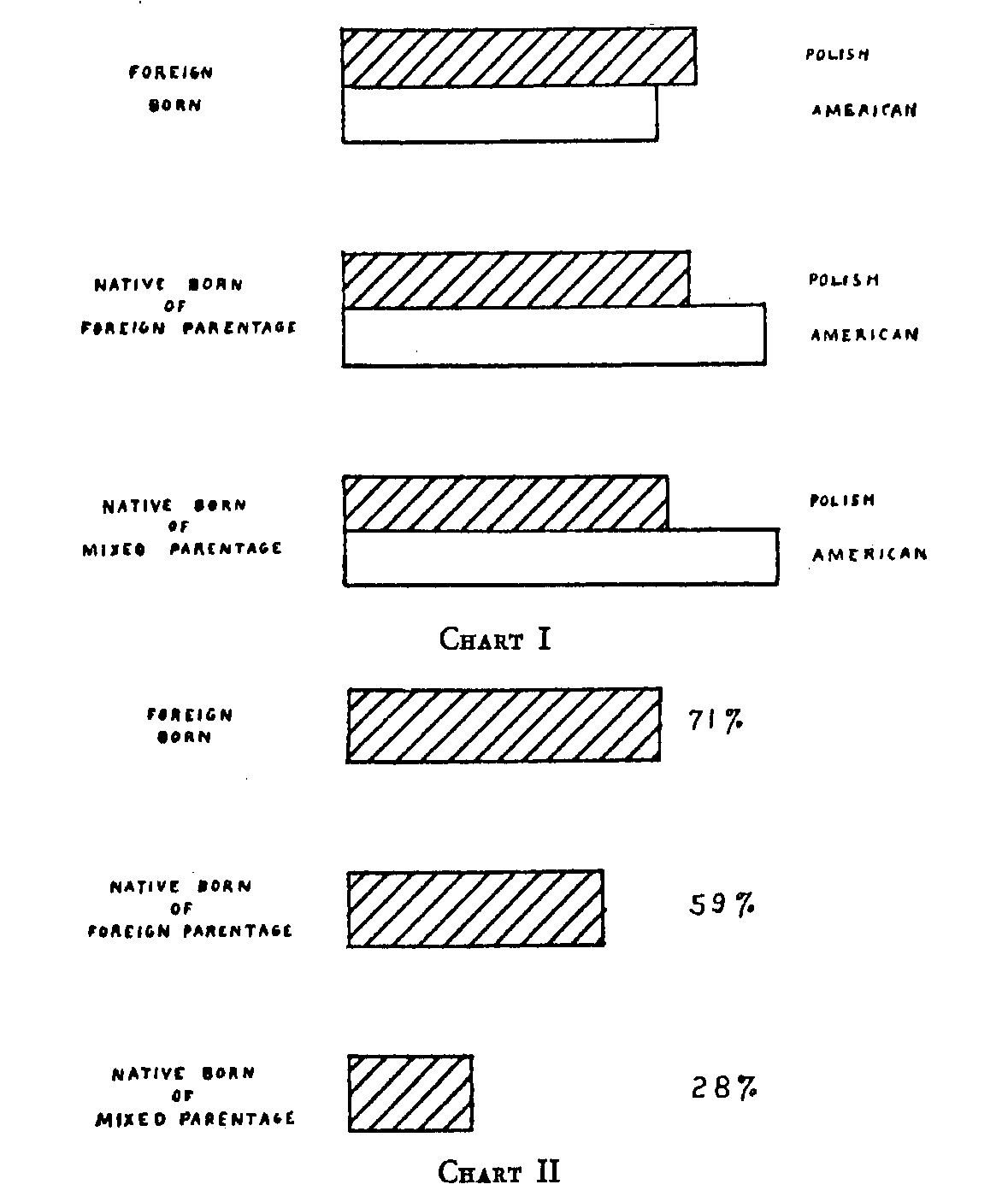
American legends and traditions is much more than the loss of Polish traditions and legends, and whereas, after three generations, the Polish-Americans in this group show a very respectable knowledge of American traditions and legends, they show only slightly less knowledge of Polish traditions and legends. This circumstance suggests the fact that culture traits are much more easily acquired than they are dropped. It also suggests the fact that certain immigrant groups arc maintaining a kind of cultural dualism. In other words, they are quite satisfactorily "Americanized" so far as this term connotes familiarity with American traditions and history, but they are not correspondingly "de-Polandized."
The material relating to the degree of observance of a number of distinctively Polish customs likewise shows significant
( 81) differences from generation to generation. Whereas the foreign born have an average score of 5 out of a possible 7 for custom observance, the native born of foreign parents have a score of 59 and the native born of mixed native and foreign parentage have a score of 28.
It may be worth observing that there seems to be a more rapid movement away from typically Polish culture patterns in respect to custom observance than there was in respect to tradition, for while the range of scores in knowledge of tradition field of the thing he actually does, and later in the
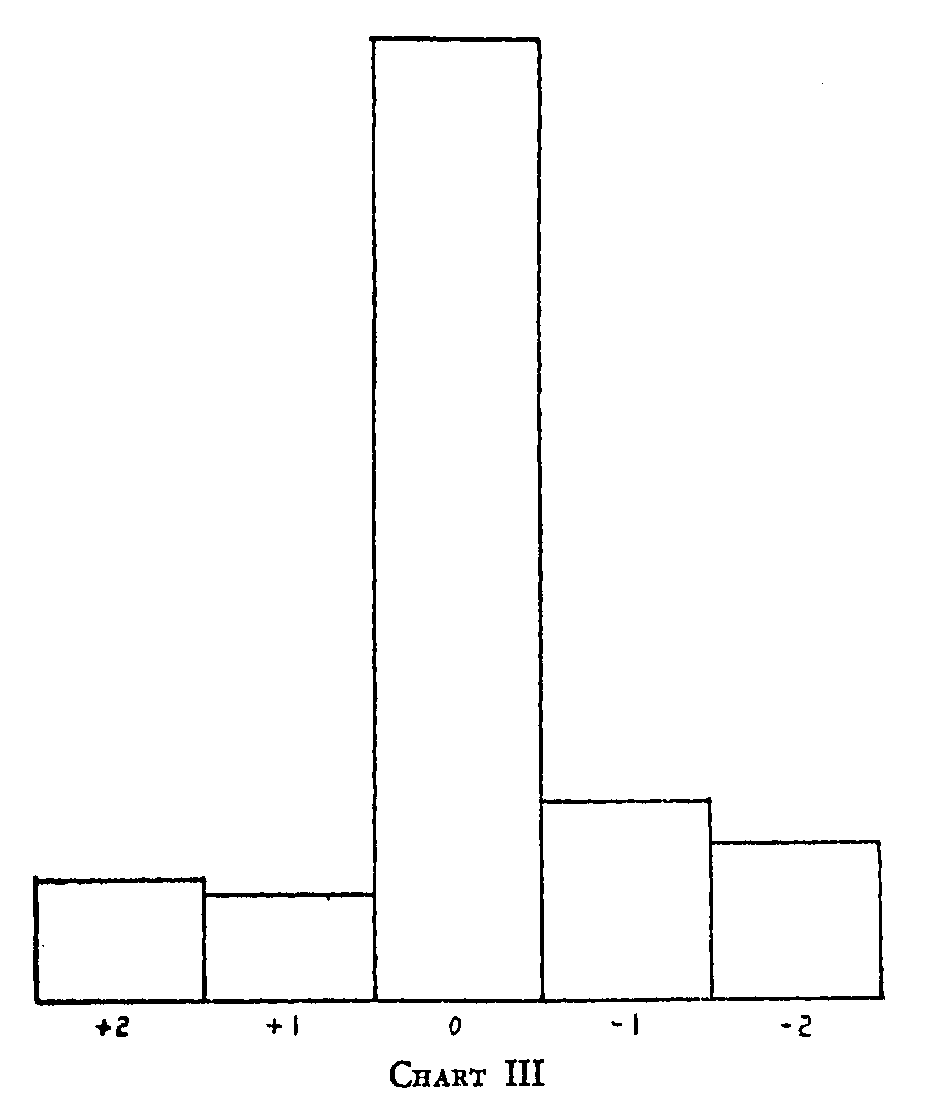
field of the things he remembers and thinks about.
The next set of material refers altogether to questions of sentiments and
ideas-more specifically, attitudes. Reference will be made first to certain
attitudes shown by the group as a whole and next to the variations produced by
age and generation differences in regard to one of the attitudes. Seventy refer
to the degree of like or dislike towards the Negro: it is surprising to note
that this group
(
82) of any factors inherent in the relations of race to race, as such.
CHANGE IN ATTITUDE TOWARD PARENTAL AUTHORITY AND PREFERENCE FOR PUBLIC SCHOOLS
A chart made for the study registers the degree of approval or disapproval expressed towards three related questions: (I) the authority of the parent over the adult child, (2) the right of the child to choose his own vocation, (3) the right of the child to choose his own mate. If this group were showing complete logical consistency, the graphs would be generally similar, for choice of vocation and choice
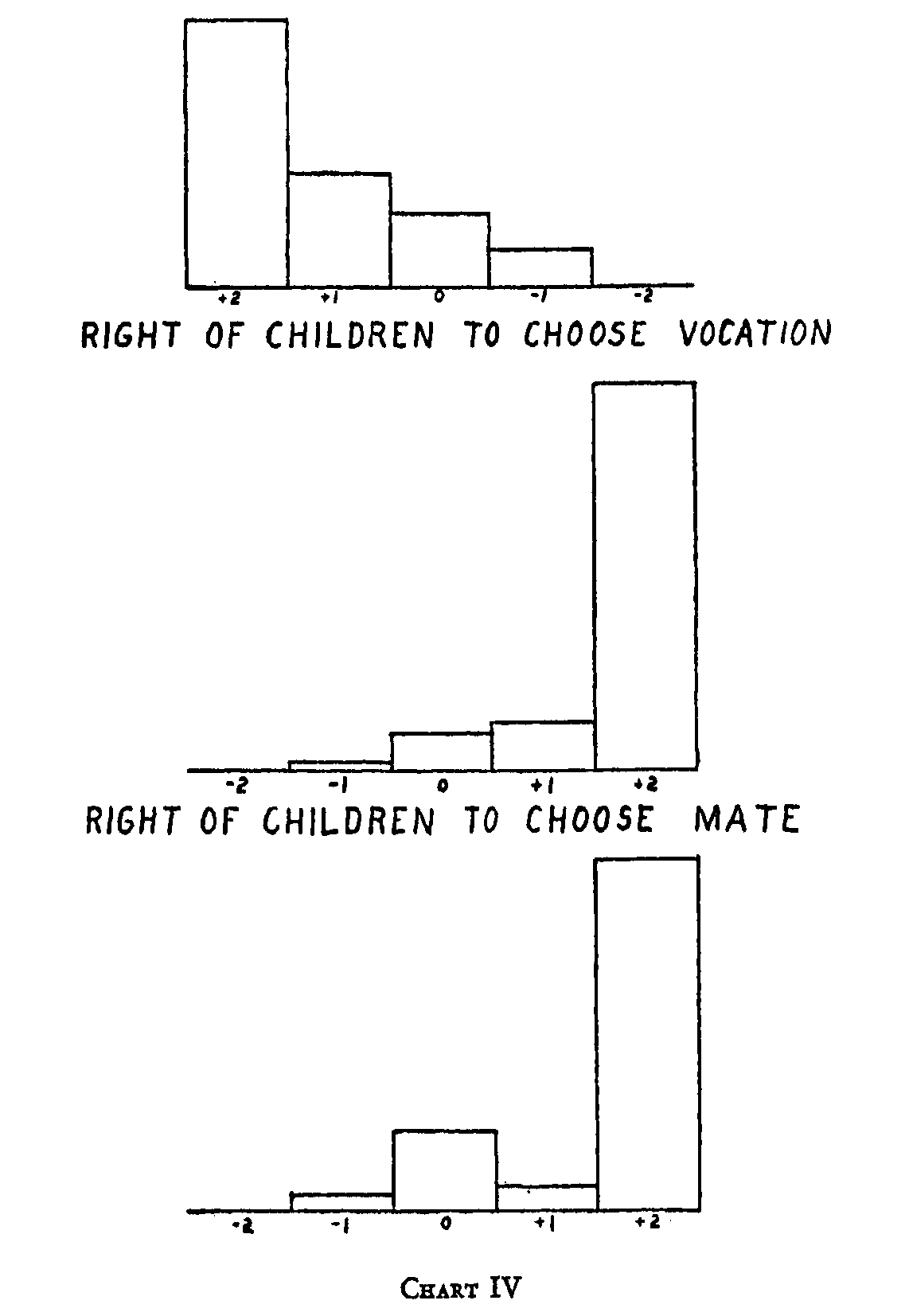
of mate are among the more important considerations involved in the authority of the parent over his child. The graphs are, however, very dissimilar. That pertaining to the authority of the parent over the adult child shows a very marked concentration in the direction of strong approval, the original data showing thirty-three individuals registering strong approval; fourteen registering mild approval, nine registering indifference, four registering mild disapproval, and none registering strong disapproval. When however it comes to actualizing this highly revered parental authority in terms of the determination of certain of the
( 83) more momentous decisions in the lives of their children, the situation is quite the reverse. There is even stronger disapproval of parental control over the child's choice of his own vocation or his own mate than there was approval of parental authority in the abstract. Out of sixty-four individuals, forty-nine expressed strong approval of the child's right to choose his vocation, six mild approval, five indifference, one mild disapproval, and none strong disapproval. The corresponding figures for the right to choose one's own mate were forty-five, three, ten, two and zero.
Inconsistent is this group, but the in-consistency is understandable and sociologically interesting. This group retains enough of its traditional old-world inheritance of a highly developed degree
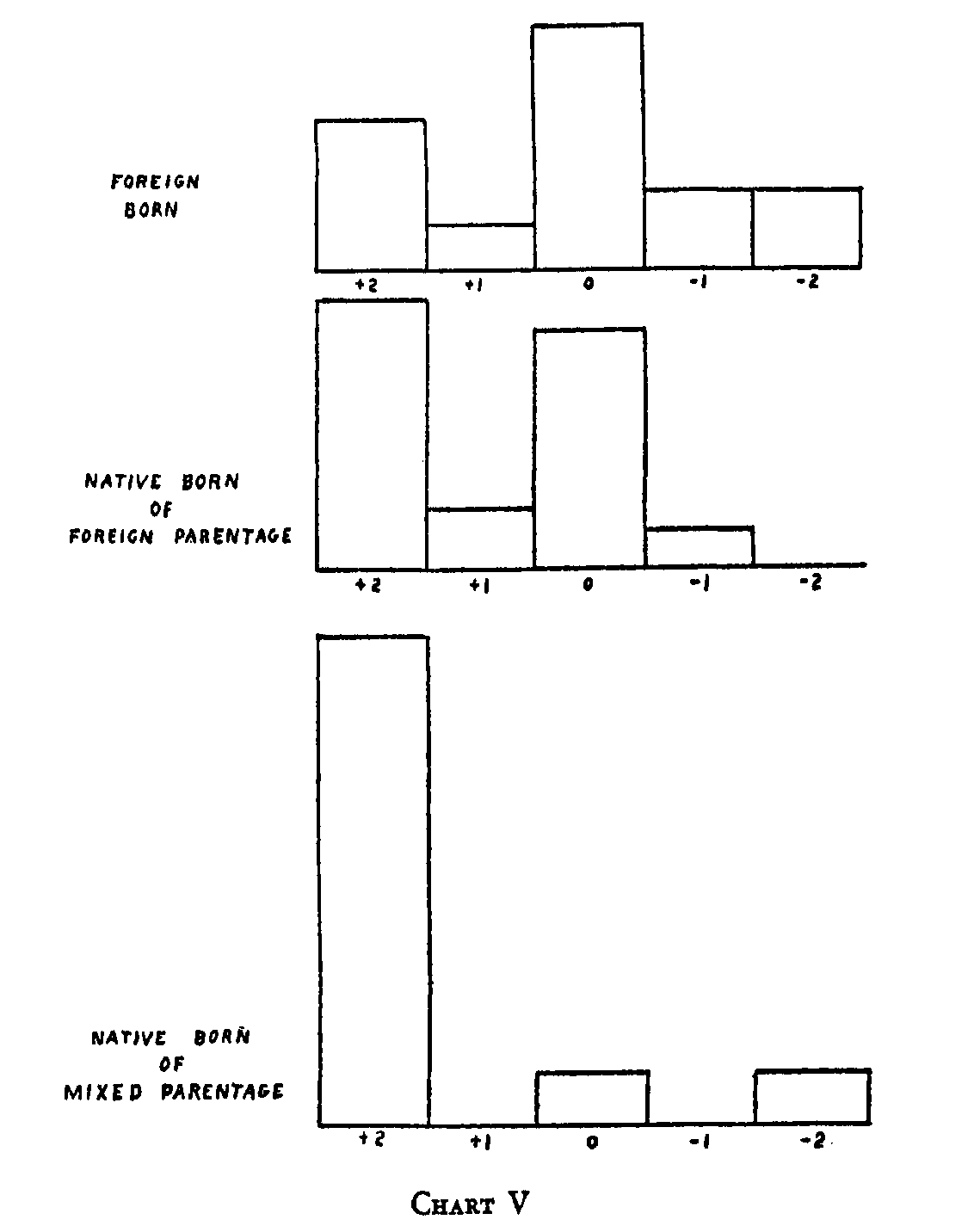
of parental authority to maintain a wholesome degree of reverence for such authority in the abstract, but when brought face to face with the significance of such authority in the life decisions of the young people concerned, adherence to it breaks down, and the group moves over to a strong degree of approval of a typically American set of attitudes, that is, the giving to the child of the virtual freedom of choice in these respects. Something like the same contrast noted above between the maintaining of ideas and sentiments on the one hand and of actual behavior habits on the other hand is to be observed here. The old norms are clung to so long as they have no specific import for concrete social situations. When, however, their significance in terms of actual decisions are realized, they are
( 84) promptly abandoned for attitudes more in consonance with the behavior situation of the general population. It is not likely that this group has gone through anything like the degree of conscious, rational, explanation which has been undertaken here. Rather, it is more likely that two groups of mental sets are involved, one embodying a carry-over of the old-world tradition, one embodying adjustment to the American situation. However this may be, the social significance of the contrasting attitudes re-mains the same.
Other charts show the attitudes of different age and generation groups to the same question, namely, the preferability of public school over the parochial school. In so far as the Polish people are overwhelmingly Roman Catholic and notably devoted to their church, any movement away from disapproval of preference for the public school would indicate movement away-at least in this respect-from a typically Polish mind-set.[3] The numbers involved are so small that a certain amount of eccentricity is to be expected. Only the general trends are worth noting.
Looking at the situation as between foreign born, native born of foreign parentage, and native born of mixed native and foreign parentage, a distinct shift is apparent. The graph for the foreign born is skewed very slightly in the direction of approval of the proposition that public schools are preferable to parochial schools; that for the native born of foreign parentage is skewed a little more in this direction, while that for native born of mixed native and foreign parentage is skewed decidedly in its favor. Graphs referring to the age group show a similar progression, the older people expressing a clear preponderance of opinion in favor of the parochial school, the younger groups, especially the youngest, express-
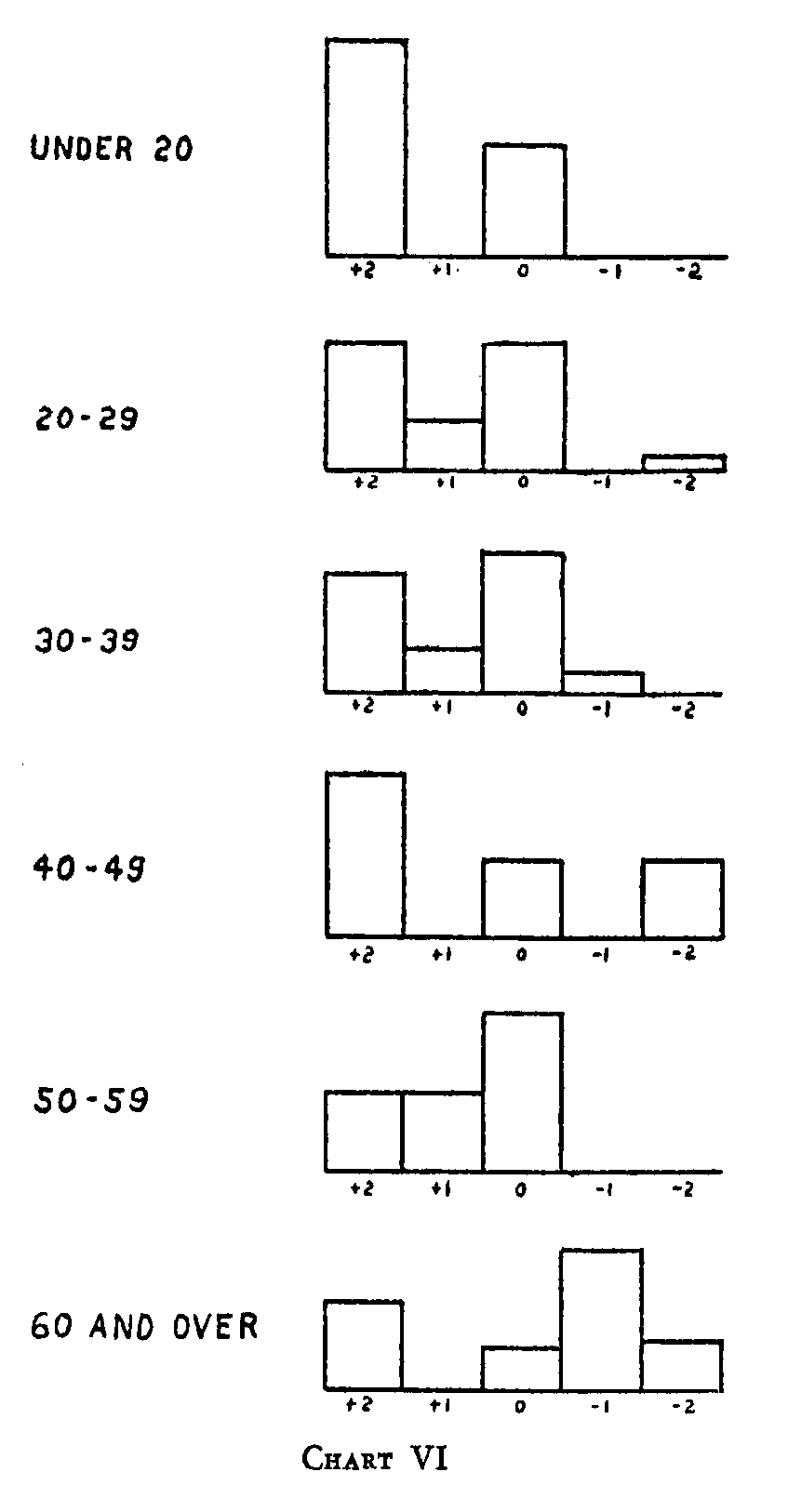
ing a preference for the public schools over the parochial schools.
These results should not be interpreted as betokening a general breaking away from the church as such. The insistence shown by every age and generation group to all questions concerning religious behavior suggests that there is about the
( 85) same type of feeling toward the church in one group as in another. What the results do suggest, however, is a modification of attitude at a point where the church's activities tie into the community at large. This modification is very notice-able and is in the direction of movement toward accommodation to the norms of the American community, from generation to generation and from age group to age group.
It is freely admitted that many of the generalizations attached to the
foregoing data are open to the criticism that the number of cases involved is
too small to make them statistically satisfactory. The writer would be only too
glad to abandon them in the face of other data on the same topics, based upon a
larger number of cases. Indeed, he would be more than happy if this paper should
serve to stimulate similar studies in other places, for his chief aim in
presenting this paper has been to attempt a demonstration of the practicability
of carrying into the fields of household economy, family structure, standards of
expenditure, family relations, habits, customs, beliefs, and opinions, the
techniques of objective and quantitative investigation and to suggest the
rewards in the form of interesting and significant sociological data that await
upon the efforts of anyone desiring to undertake such studies.